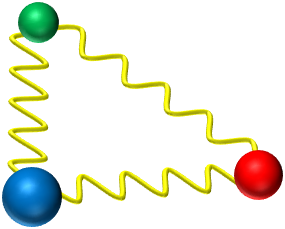Few-Body Systems
Understanding systems of interacting particles is one of the key challenges of physics, and has both fundamental and technological relevance. Such systems generally cannot be fully described in closed analytical form (mathematical expressions that can be written down) for more than two particles, even if their individual properties and the forces between them are precisely known. This dilemma is well-known as the "few-body problem" and it limits the extent to which one can predict the states of the particles (e.g. their positions and velocities) for any time in the future. Therefore, advancing the knowledge of phenomena that emerge due to the complex interplay of several particles requires the joined theoretical and experimental exploration for a wide range of situations. In this project, few-body phenomena of quantum systems consisting of atoms, their electrically charged components (electrons and ions), and photons (the particles of light) will be studied. Such quantum systems represent an ideal testing ground of few-body physics for multiple reasons: First, few-body effects in these systems are ubiquitous and relevant to many research fields and numerous technical applications, particularly in areas such as materials science, quantum chemistry, biological science, and information processing. Second, advanced experimental techniques are available which allow manipulation of the parameters of the few-particle quantum state with a high degree of control and accuracy. Moreover, modern spectrometers enable snapshots to be taken of the state's change over time, allowing details of the state's dynamics to be analyzed. Techniques for the control of atomic few-body systems and for the analysis of their dynamics which have been developed in the past twenty years (largely independently of each other) will be combined in the present project for the first time. This will enable the observation of few-body quantum phenomena while being able to tune the system parameters, and it will allow benchmarking theoretical models.
On a more technical level, this project involves the control and analysis of atomic few-body systems using laser cooling and manipulation techniques to prepare a large variety of initial states, ranging from single excited or polarized lithium atoms to large ensembles of atoms that are cooled to quantum-degeneracy. Systems of only very few atoms can be confined in a micrometer-sized optical dipole trap and their interaction can be tuned close to Feshbach resonances. For the analysis, a "reaction microscope" will be employed allowing the coincident measurements of the momentum vectors of atomic fragments after ionization of the lithium atoms by femtosecond or attosecond laser pulses. In essence, there are three fundamental questions to be addressed in the proposed experiments: First, how do the ionization dynamics depend on the relative orientation (or helicity) of an ionizing laser field and a polarized target atom? Such experiments will help to understand fundamental symmetries and ultimately control the interaction of laser fields with chiral (atomic or molecular) targets, which play a crucial role e.g. in biochemistry. Second, how is the disintegration of an atom due to the interaction with an ionizing field influenced by its environment? This is experimentally only studied for clusters or solid targets, but largely unexplored for more dilute systems. Apart from the fundamental importance of this question, the dependence of the ionization dynamics on the environment is relevant to the understanding of the damage of biological tissue due to radiation. Finally, how does the correlated wave function of a few-particle system change as a function of the particle number and interaction type and strength? The possibility to "engineer" simple few-body systems and observe such systems comprehensively would allow one to "simulate" and understand fundamental quantum phenomena that occur in natural or artificial materials.
Examples
the 'Kepler-Problem' with 3 or more celestial bodies (e.g. sun, earth, and Jupiter)
Scattering of nuclear or atomic particles
Formation and stability of nuclei
Three-body recombination processes and formation of molecules
...

Quantum gases: Tunable Few-Body Systems
Progress in cooling, trapping and manipulating of ultracold samples enables nowadays to experimentally study few-body phenomena in trapped atomic and molecular systems with unprecedented control. Ensembles of atoms in optical traps are largely isolated from their environment. Their dynamics can be probed in detail on experimentally accessible time scales. At the same time many parameters like temperature, density, interaction strengths, and also the number of particles can be tuned allowing the realization of many different physical situations.